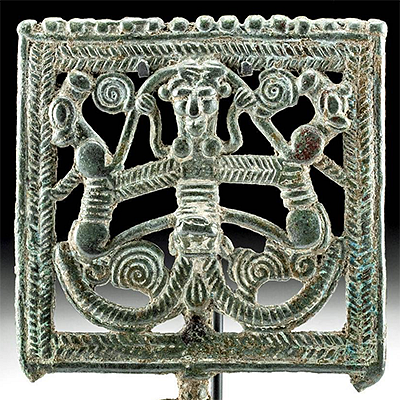Framed Chancay Polychrome Textile Panel w/ Figures
Lot 62a
About Seller
Artemis Gallery
686 S Taylor Ave, Ste 106
Louisville, CO 80027
United States
Selling antiquities, ancient and ethnographic art online since 1993, Artemis Gallery specializes in Classical Antiquities (Egyptian, Greek, Roman, Near Eastern), Asian, Pre-Columbian, African / Tribal / Oceanographic art. Our extensive inventory includes pottery, stone, metal, wood, glass and textil...Read more
Estimate:
$1,200 - $1,800
Absentee vs Live bid
Two ways to bid:
- Leave a max absentee bid and the platform will bid on your behalf up to your maximum bid during the live auction.
- Bid live during the auction and your bids will be submitted real-time to the auctioneer.
Bid Increments
| Price | Bid Increment |
|---|---|
| $0 | $25 |
| $300 | $50 |
| $1,000 | $100 |
| $2,000 | $250 |
| $5,000 | $500 |
| $10,000 | $1,000 |
| $20,000 | $2,500 |
| $50,000 | $5,000 |
| $100,000 | $10,000 |
| $200,000 | $20,000 |
About Auction
By Artemis Gallery
Nov 5, 2020
Set Reminder
2020-11-05 10:00:00
2020-11-05 10:00:00
America/New_York
Bidsquare
Bidsquare : Ancient & Ethnographic From Around the World
https://www.bidsquare.com/auctions/artemis-gallery/ancient-ethnographic-from-around-the-world-5916
Ancient art from Egypt, Greece, Italy and the Near East, as well as Asian, Pre-Columbian, Native American, African / Tribal / Oceanic, Spanish Colonial, Russian Icons, Fine art, much more! All categories, all price ranges... all legally acquired and guaranteed to be as described or your money back. Artemis Gallery info@artemisgallery.com
Ancient art from Egypt, Greece, Italy and the Near East, as well as Asian, Pre-Columbian, Native American, African / Tribal / Oceanic, Spanish Colonial, Russian Icons, Fine art, much more! All categories, all price ranges... all legally acquired and guaranteed to be as described or your money back. Artemis Gallery info@artemisgallery.com
- Lot Description
Pre-Columbian, north coast Peru, Chancay, ca. 1300 to 1470 CE. A fabulous example of a sizable textile panel comprised of tightly-woven camelid (alpaca or llama wool) fibers in hues of beige, coral, marigold, teal, dark green, and crimson. Sprawled across the front are five abstract anthropomorphic figures standing upon delineated legs with outstretched arms and presenting minimalist countenances beneath grand headdresses with pairs of downward-facing serpents. Also shown are five abstract simian creatures with spotted bodies, arms clasping to rod-form poles, and rabbit-ear headdresses, and eight petite, highly stylized birds are interspersed within the surrounding areas. Size (textile): 46.25" W x 21.4" H (117.5 cm x 54.4 cm); (frame): 52.8" W x 28.5" H (134.1 cm x 72.4 cm)
The people of the early cultures in the Andes buried their dead in bundles with woven textiles, sometimes wearing clothing like this panel. These often have repetitive, almost fractal patterns, often placed inside of frames, and with color sequences designed to make the viewer look across them diagonally. The red color is probably from cochineal, a bright red insect, while the yellow and green colors would have come from various plants. The dry, cold climate of the Andes preserved these textiles. As time went on, their designs changed - from ca. 1300 CE onward, motifs began to emphasize anthropomorphic figures rather than geometric abstractions. The iconography of these textiles remains unclear, but some scholars have advanced the theory that figures shown face on (like the ones on this textile) are gods.
Provenance: private California, USA collection; ex-Helm auction house, California, USA, 1990's, acquired from a la Mesa estate
All items legal to buy/sell under U.S. Statute covering cultural patrimony Code 2600, CHAPTER 14, and are guaranteed to be as described or your money back.
A Certificate of Authenticity will accompany all winning bids.
We ship worldwide and handle all shipping in-house for your convenience.
#159536Small losses to both lateral peripheries as shown. Minor fraying and loosening to some interior and peripheral fibers, with light staining and fading to original pigmentation, and some creasing. Great remains of pigmentation and figural motifs throughout.Condition
- Shipping Info
-
All shipping is handled in-house for your convenience. Your invoice from Artemis Gallery will include shipping calculation instructions. If in doubt, please inquire BEFORE bidding for estimated shipping costs for individual items.
-
- Buyer's Premium



 EUR
EUR CAD
CAD AUD
AUD GBP
GBP MXN
MXN HKD
HKD CNY
CNY MYR
MYR SEK
SEK SGD
SGD CHF
CHF THB
THB















